
Straight Up is the fourth studio album by the British rock band Badfinger, released in December 1971 in the United States and February 1972 in Britain. Issued on the Beatles' Apple record label, it includes the hit singles "Day After Day" and "Baby Blue", and the similarly popular "Name of the Game", all of which were written by singer and guitarist Pete Ham. The album marked a departure from the more rock-oriented sound of Badfinger's previous releases, partly as a result of intervention by Apple Records regarding the band's musical direction.
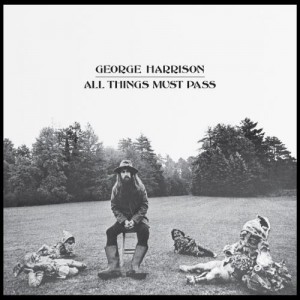
All Things Must Pass is the third studio album by English rock musician George Harrison. Released as a triple album in November 1970, it was Harrison's first solo work after the break-up of the Beatles in April that year. It includes the hit singles "My Sweet Lord" and "What Is Life", as well as songs such as "Isn't It a Pity" and the title track that had been overlooked for inclusion on releases by the Beatles. The album reflects the influence of Harrison's musical activities with artists such as Bob Dylan, the Band, Delaney & Bonnie and Friends and Billy Preston during 1968–70, and his growth as an artist beyond his supporting role to former bandmates John Lennon and Paul McCartney. All Things Must Pass introduced Harrison's signature slide guitar sound and the spiritual themes present throughout his subsequent solo work. The original vinyl release consisted of two LPs of songs and a third disc of informal jams titled Apple Jam. Several commentators interpret Barry Feinstein's album cover photo, showing Harrison surrounded by four garden gnomes, as a statement on his independence from the Beatles.

Dark Horse is the fifth studio album by English rock musician George Harrison. It was released on Apple Records in December 1974 as the follow-up to Living in the Material World. Although keenly anticipated on release, Dark Horse is associated with the controversial North American tour that Harrison staged with Indian classical musician Ravi Shankar in November and December that year. This was the first US tour by a member of the Beatles since 1966, and the public's nostalgia for the band, together with Harrison contracting laryngitis during rehearsals and choosing to feature Shankar so heavily in the programme, resulted in scathing concert reviews from some influential music critics.

The discography of English singer-songwriter and ex-Beatle George Harrison consists of 12 studio albums, two live albums, four compilation albums, 35 singles, two video albums and four box sets. Harrison's first solo releases – the Wonderwall Music film soundtrack (1968) and Electronic Sound (1969) – were almost entirely instrumental works, issued during the last two years of the Beatles' career. Following the band's break-up in April 1970, Harrison continued to produce recordings by his fellow Apple Records acts, notably former bandmate Ringo Starr. He recorded and collaborated with a wide range of artists, including Shankar, Bob Dylan, Eric Clapton and Gary Wright.
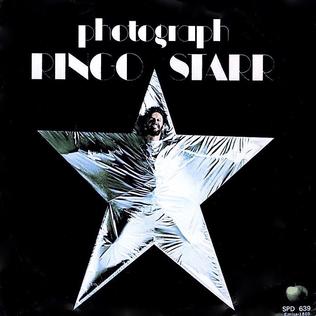
"Photograph" is a song by English rock musician Ringo Starr that was released as the lead single from his 1973 album Ringo. Starr co-wrote it with George Harrison, his former bandmate from the Beatles. Although they collaborated on other songs, it is the only one officially credited to the pair. A signature tune for Starr as a solo artist, "Photograph" was an international hit, topping singles charts in the United States, Canada and Australia, and receiving gold disc certification for US sales of 1 million. Music critics have similarly received the song favourably; Stephen Thomas Erlewine of AllMusic considers it to be "among the very best post-Beatles songs by any of the Fab Four".

The Concert for Bangladesh is a live triple album credited to "George Harrison & Friends" and released on Apple Records in December 1971 in America and January 1972 in Britain. The album followed the two concerts of the same name, held on 1 August 1971 at New York's Madison Square Garden, featuring Harrison, Bob Dylan, Ravi Shankar, Ali Akbar Khan, Ringo Starr, Billy Preston, Leon Russell and Eric Clapton. The shows were a pioneering charity event, in aid of the homeless Bengali refugees of the Bangladesh Liberation War, and set the model for future multi-artist rock benefits such as Live Aid (1985) and the Concert for New York City (2001). The event brought Harrison and Starr together on a concert stage for the first time since 1966, when the Beatles retired from live performance, and represented Dylan's first major concert appearance in the US in five years.

Encouraging Words is the fifth studio album by American soul musician Billy Preston, released in September 1970 on Apple Records. It was the last of Preston's two albums for the Beatles' Apple label, after which he moved to A&M Records. The album was co-produced by George Harrison and Preston. Harrison's songs "All Things Must Pass" and "My Sweet Lord" were issued here for the first time, two months before his own recordings appeared on his triple album All Things Must Pass.
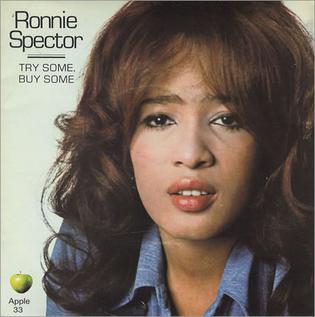
"Try Some, Buy Some" is a song written by English rock musician George Harrison that was first released in April 1971 as a single by American singer Ronnie Spector, formerly the lead vocalist of the Ronettes. She recorded it in London along with other Harrison compositions for a planned comeback album on the Beatles' Apple record label. The project was co-produced by Phil Spector, Ronnie's husband at the time, but abandoned following recording sessions that were hampered by his erratic behaviour. The only official release from the sessions, the single achieved minimal commercial success, peaking at number 77 on the US Billboard Hot 100 and number 63 on Canada's RPM Top 100. Harrison later added his own vocal onto a new mix of the instrumental track and included the song on his 1973 album Living in the Material World.
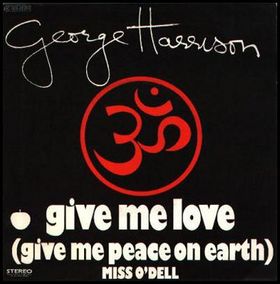
"Give Me Love " is a song by English musician George Harrison, released as the opening track of his 1973 album Living in the Material World. It was also issued as the album's lead single, in May that year, and became Harrison's second US number 1, after "My Sweet Lord". In doing so, the song pushed Paul McCartney and Wings' "My Love" from the top of the Billboard Hot 100, marking the only occasion that two former Beatles have held the top two chart positions in America. The single also reached the top ten in Britain, Canada, Australia and other countries around the world.

"Dark Horse" is a song by English rock musician George Harrison and the title track to his 1974 solo album on Apple Records. The song was the album's lead single in North America, becoming a top-20 hit in the United States, but it was Harrison's first single not to chart in Britain when issued there in February 1975. The term "dark horse" had long been applied to Harrison due to his unexpected emergence as the most accomplished solo artist of the four former Beatles following the band's break-up in 1970. In the song, however, he said he used the phrase in reference to gossip about someone who carries out clandestine sexual relationships. Commentators interpret the lyrics as a rebuttal to several possible detractors: Harrison's first wife, Pattie Boyd; reviewers who criticised the spiritual content of his 1973 album Living in the Material World; and his former bandmates John Lennon and Paul McCartney. Harrison named his Dark Horse record label after the song, and his 1974 North American tour with Ravi Shankar came to be known as the Dark Horse Tour.
"Don't Let Me Wait Too Long" is a song by English rock musician George Harrison, released on his 1973 album Living in the Material World. It was scheduled to be issued as a single in September that year, as the follow-up to "Give Me Love ", but the release was cancelled. Music critics have traditionally viewed "Don't Let Me Wait Too Long" as a highlight of the Material World album, praising its pop qualities and production, with some considering the song worthy of hit status.

"Day After Day" is a song by the British rock band Badfinger from their 1971 album Straight Up. It was written by Pete Ham and produced by George Harrison, who also plays slide guitar on the recording. The song was issued as a single and became Badfinger's biggest hit, charting at number 4 in the United States and number 10 in the UK, ultimately earning gold accreditation from the Recording Industry Association of America.

"Isn't It a Pity" is a song by English rock musician George Harrison from his 1970 solo album All Things Must Pass. It appears in two variations there: one the well-known, seven-minute version; the other a reprise, titled "Isn't It a Pity ". Harrison wrote the song in 1966, but it was rejected for inclusion on releases by the Beatles. In many countries around the world, the song was also issued on a double A-side single with "My Sweet Lord". In America, Billboard magazine listed it with "My Sweet Lord" when the single topped the Hot 100 chart, while in Canada, "Isn't It a Pity" reached number 1 as the preferred side.
"You and Me (Babe)" is a song by English musician Ringo Starr, released as the final track on his 1973 album Ringo. Starr's fellow ex-Beatle George Harrison wrote the song along with Mal Evans, the Beatles' longtime aide and a personal assistant to Starr during the making of Ringo. The track serves as a farewell from Starr to his audience in the manner of a show-closing finale, by lyrically referring to the completion of the album. During the extended fadeout, Starr delivers a spoken message in which he thanks the musicians and studio personnel who helped with the recording of Ringo – among them, Harrison, John Lennon and Paul McCartney, and his producer, Richard Perry.
"I'll Still Love You" is a song written by English rock musician George Harrison and first released in 1976 by his former Beatles bandmate Ringo Starr. Produced by Arif Mardin, the track appeared on Starr's debut album for Atlantic Records and Polydor, Ringo's Rotogravure. The composition had a long recording history before then, having been written in 1970 as "Whenever", after which it was copyrighted with the title "When Every Song Is Sung".
Lon & Derrek Van Eaton were an American vocal and multi-instrumentalist duo from Trenton, New Jersey, consisting of brothers Lon and Derrek Van Eaton. They are best known for their association with the Beatles through the brothers' brief stint on Apple Records, and for their subsequent session work in Los Angeles for producer Richard Perry. As well as recording their own albums, during the 1970s they appeared on releases by artists including George Harrison, Ringo Starr, Harry Nilsson, Carly Simon, Martha Reeves and Art Garfunkel. Beatles biographer Robert Rodriguez describes the Van Eaton brothers as arguably the closest the Apple record label came to delivering on its initial promise of "plucking unknowns from obscurity" and launching them as successful recording artists.

The Place I Love is the debut album by English vocal duo Splinter, released on Dark Horse Records in September 1974. It was the first album released by the Dark Horse label, which was owned by George Harrison, who also produced the album. Recording sessions took place at Harrison's Friar Park home studio in Oxfordshire and featured extensive musical contributions from Harrison, on guitar, keyboards and other instruments, as well as participants such as Gary Wright, Billy Preston, Jim Keltner and Alvin Lee. "Costafine Town", the first single from the album, was a top-twenty hit in the United Kingdom and other countries.
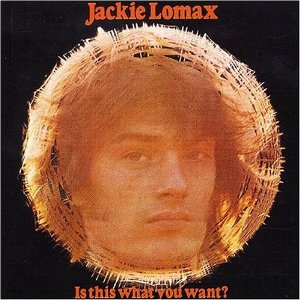
Is This What You Want? is the debut album by English rock and soul singer Jackie Lomax, released in 1969 on the Beatles' Apple record label. It is notable for the involvement of three Beatles: It was produced by George Harrison and features contributions from Harrison, Paul McCartney and Ringo Starr. The album includes Lomax's debut single for Apple, the Harrison-written "Sour Milk Sea", while the US version added "New Day", which was produced by Lomax and released as a non-album single in Britain.

Doris Troy is an album released in 1970 on the Beatles' Apple Records label by American soul singer Doris Troy. It features songs written by Troy and a number of the participants on the sessions, including George Harrison, Stephen Stills, Klaus Voormann and Ringo Starr. Through the extended period of recording, the album became an all-star collaborative effort, typical of many Apple projects during 1968–70, although it was Troy's only album on the Beatles' label. Other guest musicians included Billy Preston, Peter Frampton, Leon Russell, Eric Clapton and members of the Delaney & Bonnie Friends band. Like the Harrison-produced single "Ain't That Cute", Doris Troy failed to chart in Britain or America on release.

The Radha Krsna Temple is a 1971 album of Hindu devotional songs recorded by the UK branch of the Hare Krishna movement – more formally, the International Society for Krishna Consciousness (ISKCON) – who received the artist credit of "Radha Krishna Temple (London)". The album was produced by George Harrison and released on the Beatles' Apple record label. It compiles two hit singles, "Hare Krishna Mantra" and "Govinda", with other Sanskrit-worded mantras and prayers that the Temple devotees recorded with Harrison from July 1969 onwards.
















